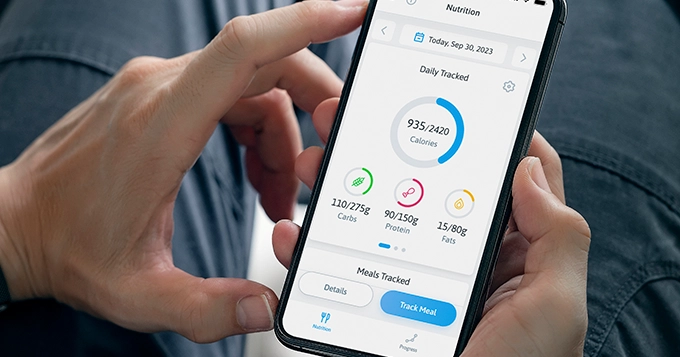You have your fitness goals. Whether you want to lose, gain, or maintain your weight, knowing how many calories you need to consume on a daily basis is essential in reaching them.
Counting calories improves your diet quality, and helps you reach certain fitness and health-related goals. It involves determining what nutrients your body needs and using a food journal or app to track your intake.
But before you track what you eat, let’s first find out how much you should be eating based on your unique body needs and goals.
In this article, we will help you learn how to calculate calories that suit your needs and goals in 5 simple steps.
Step 1: Determine Your Basal Metabolic Rate (BMR)
Basal metabolic rate (BMR) is sometimes referred to as the resting metabolic rate which is the minimum number of calories required for basic physiological functions at rest. Calculating your BMR can be used as a starting point to estimate the baseline number of calories your body requires to function and to calculate how many calories you need to consume to reach your goals.
Calculating BMR is different for women and men.
How to calculate BMR for women:
BMR = 655.1 + (9.563 x weight in kilogram) + (1.850 x height in centimeters) – (4.676 x age in years)
How to calculate BMR for men:
BMR = 66.47 + (13.75 x weight in kilogram) + (5.003 x height in centimeters) – (6.755 x age in years)
Step 2: Calculate Your Total Daily Energy Expenditure or (TDEE)
Your Total Daily Energy Expenditure (TDEE) is an estimate of your daily caloric expenditure or the number of calories you burn per day when exercise is taken into account. To calculate your TDEE, first, calculate your Basal Metabolic Rate, then multiply that value by an activity multiplier.
Assess how active you are when it comes to physical exercises and refer to your respective activity multiplier (a number that represents different levels of activity):
Sedentary (Little to no exercise)
BMR x 1.2
Light (exercises once or thrice a week)
BMR x 1.3
Moderate (exercises thrice to five times a week)
BMR x 1.55
Heavy (Hard exercise six to seven days a week)
BMR x 1.725
Extra active (If you have a highly physical job, do hard exercise 2 or more times per day, or train for a marathon, or triathlon)
BMR x 1.9
Step 3: Set Your Calorie Goals
A calorie is a unit that measures energy. Calories are usually used to measure the energy content of foods and beverages which brings us to the next step – setting calorie goals.
Calculating the total calories you should consume daily also depends on your fitness goals. So, assess your objectives and determine what to do with your BMR and TDEE using the guide below:
Goal: Lose weight
Once you know your TDEE, all you need to do is make sure your caloric intake is less than that number! Know your daily caloric intake and subtract 500 from that.
Goal: Gain weight
You might be asking how to calculate calorie intake that takes you closer to your goal of gaining weight. The key is to ensure your calorie intake is higher than your TDEE. Know your daily caloric intake and add 350 calories.
Goal: Maintain weight
If you want to maintain your current weight, consuming the exact amount of calories demanded by your TDEE is recommended.
Great! Now you know how to calculate your BMR and TDEE and have set a clear fitness goal. It’s time to know how to calculate calorie in what you consume and track your nutrition.
Step 4: Track Your Food Intake
To make the most out of your health and fitness routine, try your best to consume the right amount of calories recommended.
You might be asking how to calculate calories in a food item. We have the answer for you. Track with precision and ease and calculate calories for the day using the Trainest App where over a million food items have accurate calories and macronutrient info in the database.
Use premium features like the food barcode scanner for free! Make your nutrition tracking experience easier so you never have to fall out of your routine again. Your nutrition report is readily available to help you understand your eating habits and make better health decisions.
Step 5: Track Your Exercise
Track your exercise and constantly update your TDEE. This not only helps you calculate how many calories you should consume daily but also how to calculate calories burned or your daily energy expenditure.
On top of it, tracking your exercise means you’re also tracking your progress. When you begin an exercise regimen, tracking your progress can encourage you to continue and help you stay motivated.
Conclusion
Counting calories can help you reach your desired weight by bringing awareness to what you eat each day. This can help you identify eating habits that you may need to modify, keeping you on track to reach your goals.
That said, calorie counting isn’t for everyone. Calories tracking for anyone with a history of disordered eating patterns might make their condition worse. Focusing on counting food intake this intently could even lead to eating disorders for others without previous experience with these behaviors.
Those using macro counting should aim — depending on their goals — to follow a nutritious, well-rounded diet rich in fresh produce, healthy fats, complex carbs, and protein sources.
Everyone who practices calorie counting should aim to follow a nutritious, well-rounded diet that meets their nutritional needs – a diet that includes fresh produce, healthy fats, complex carbs, and protein sources.
Let Trainest calculate and set precise calorie and macronutrient values that align with your health and fitness goals, allowing you to stay on top of your calories and macros effortlessly.
Download the app and be among the first to experience Trainest for free.








